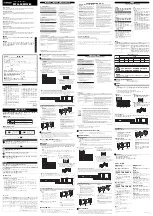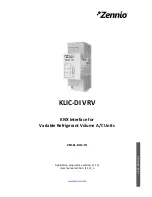
5-312
L60 LINE PHASE COMPARISON SYSTEM – INSTRUCTION MANUAL
CONTROL ELEMENTS
CHAPTER 5: SETTINGS
5
Synchrocheck verifies that the voltages (V1 and V2) on the two sides of the supervised circuit breaker are within set limits
of magnitude, angle, and frequency differences. The time that the two voltages remain within the admissible angle
difference is determined by the setting of the phase angle difference
ΔΦ
and the frequency difference
Δ
F (slip frequency). It
can be defined as the time it takes the voltage phasor V1 or V2 to traverse an angle equal to 2
×
ΔΦ
at a frequency equal
to the frequency difference
Δ
F. This time is calculated by:
Eq. 5-30
where
ΔΦ
is phase angle difference in degrees
Δ
F is frequency difference in Hz
If one or both sources are de-energized, the synchrocheck programming can allow for closing of the circuit breaker using
undervoltage control to bypass the synchrocheck measurements (dead source function).
SYNCHK1 V1 SOURCE
— This setting selects the source for voltage V1 (see the Notes section that follows).
SYNCHK1 V2 SOURCE
— Selects the source for voltage V2, which must not be the same as used for the V1 (see Notes).
SYNCHK1 MAX VOLT DIFF
— Selects the maximum primary voltage difference in volts between the two sources. A primary
voltage magnitude difference between the two input voltages below this value is within the permissible limit for
synchronism.
SYNCHK1 MAX ANGLE DIFF
— Selects the maximum angular difference in degrees between the two sources. An angular
difference between the two input voltage phasors below this value is within the permissible limit for synchronism.
SYNCHK1 MAX FREQ HYSTERESIS
— Specifies the required hysteresis for the maximum frequency difference condition. The
condition becomes satisfied when the frequency difference becomes lower than
SYNCHK1 MAX FREQ DIFF
. Once the
Synchrocheck element has operated, the frequency difference must increase above the
SYNCHK1 MAX FREQ DIFF + SYNCHK1
MAX FREQ HYSTERESIS
sum to drop out (assuming the other two conditions, voltage and angle, remain satisfied).
SYNCHK1 SYNC CLOSE
— Enables the dynamic mode of synchrocheck. When it is enabled, the location of where the present
V2 vector will be arriving to synchronize (shown as V2' in the figures here) with breaker close time being taken into account
will be predicted based on the measured slip frequency so that breaker close command can be issued in advance to
ensure the synchronism at the time when the breaker is actually closed.
Figure 5-178: Synchrocheck plot for slip > 0 (slip = F2-F1)
Содержание L60
Страница 10: ...x L60 LINE PHASE COMPARISON SYSTEM INSTRUCTION MANUAL TABLE OF CONTENTS ...
Страница 14: ...1 4 L60 LINE PHASE COMPARISON SYSTEM INSTRUCTION MANUAL FOR FURTHER ASSISTANCE CHAPTER 1 INTRODUCTION 1 ...
Страница 122: ...3 72 L60 LINE PHASE COMPARISON SYSTEM INSTRUCTION MANUAL CONNECT TO D400 GATEWAY CHAPTER 3 INSTALLATION 3 ...
Страница 590: ...5 382 L60 LINE PHASE COMPARISON SYSTEM INSTRUCTION MANUAL TESTING CHAPTER 5 SETTINGS 5 ...
Страница 632: ...7 12 L60 LINE PHASE COMPARISON SYSTEM INSTRUCTION MANUAL TARGETS MENU CHAPTER 7 COMMANDS AND TARGETS 7 ...
Страница 736: ...A 14 L60 LINE PHASE COMPARISON SYSTEM INSTRUCTION MANUAL FLEXANALOG ITEMS APPENDIX A FLEXANALOG OPERANDS A ...
Страница 744: ...C 6 L60 LINE PHASE COMPARISON SYSTEM INSTRUCTION MANUAL COMMAND LINE INTERFACE APPENDIX C COMMAND LINE INTERFACE C ...
Страница 752: ...iv L60 LINE PHASE COMPARISON SYSTEM INSTRUCTION MANUAL ABBREVIATIONS ...
















































